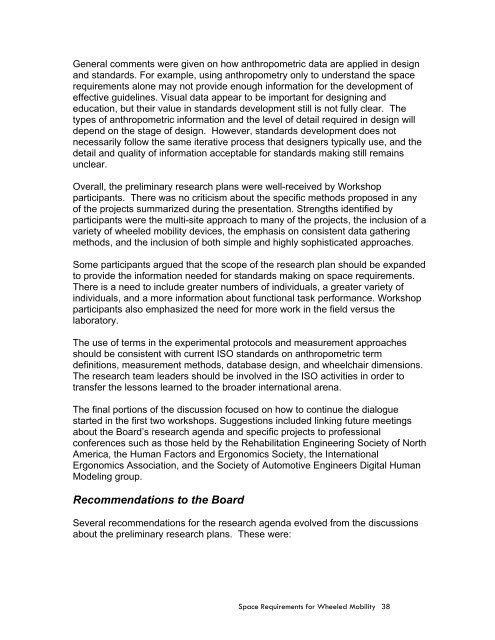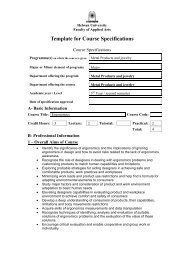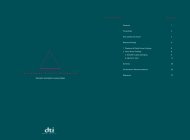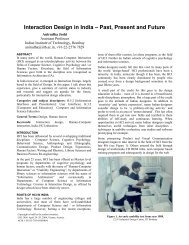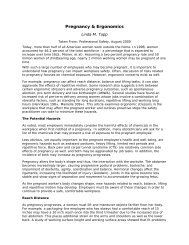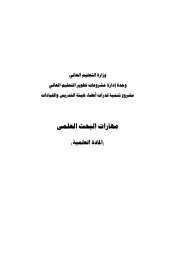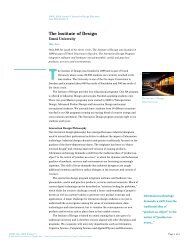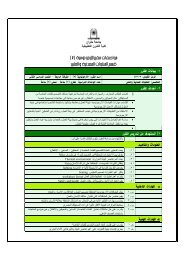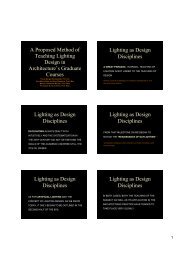Space Requirements for Wheeled Mobility - University at Buffalo ...
Space Requirements for Wheeled Mobility - University at Buffalo ...
Space Requirements for Wheeled Mobility - University at Buffalo ...
- No tags were found...
You also want an ePaper? Increase the reach of your titles
YUMPU automatically turns print PDFs into web optimized ePapers that Google loves.
General comments were given on how anthropometric d<strong>at</strong>a are applied in designand standards. For example, using anthropometry only to understand the spacerequirements alone may not provide enough in<strong>for</strong>m<strong>at</strong>ion <strong>for</strong> the development ofeffective guidelines. Visual d<strong>at</strong>a appear to be important <strong>for</strong> designing andeduc<strong>at</strong>ion, but their value in standards development still is not fully clear. Thetypes of anthropometric in<strong>for</strong>m<strong>at</strong>ion and the level of detail required in design willdepend on the stage of design. However, standards development does notnecessarily follow the same iter<strong>at</strong>ive process th<strong>at</strong> designers typically use, and thedetail and quality of in<strong>for</strong>m<strong>at</strong>ion acceptable <strong>for</strong> standards making still remainsunclear.Overall, the preliminary research plans were well-received by Workshopparticipants. There was no criticism about the specific methods proposed in anyof the projects summarized during the present<strong>at</strong>ion. Strengths identified byparticipants were the multi-site approach to many of the projects, the inclusion of avariety of wheeled mobility devices, the emphasis on consistent d<strong>at</strong>a g<strong>at</strong>heringmethods, and the inclusion of both simple and highly sophistic<strong>at</strong>ed approaches.Some participants argued th<strong>at</strong> the scope of the research plan should be expandedto provide the in<strong>for</strong>m<strong>at</strong>ion needed <strong>for</strong> standards making on space requirements.There is a need to include gre<strong>at</strong>er numbers of individuals, a gre<strong>at</strong>er variety ofindividuals, and a more in<strong>for</strong>m<strong>at</strong>ion about functional task per<strong>for</strong>mance. Workshopparticipants also emphasized the need <strong>for</strong> more work in the field versus thelabor<strong>at</strong>ory.The use of terms in the experimental protocols and measurement approachesshould be consistent with current ISO standards on anthropometric termdefinitions, measurement methods, d<strong>at</strong>abase design, and wheelchair dimensions.The research team leaders should be involved in the ISO activities in order totransfer the lessons learned to the broader intern<strong>at</strong>ional arena.The final portions of the discussion focused on how to continue the dialoguestarted in the first two workshops. Suggestions included linking future meetingsabout the Board’s research agenda and specific projects to professionalconferences such as those held by the Rehabilit<strong>at</strong>ion Engineering Society of NorthAmerica, the Human Factors and Ergonomics Society, the Intern<strong>at</strong>ionalErgonomics Associ<strong>at</strong>ion, and the Society of Automotive Engineers Digital HumanModeling group.Recommend<strong>at</strong>ions to the BoardSeveral recommend<strong>at</strong>ions <strong>for</strong> the research agenda evolved from the discussionsabout the preliminary research plans. These were:<strong>Space</strong> <strong>Requirements</strong> <strong>for</strong> <strong>Wheeled</strong> <strong>Mobility</strong> 38


